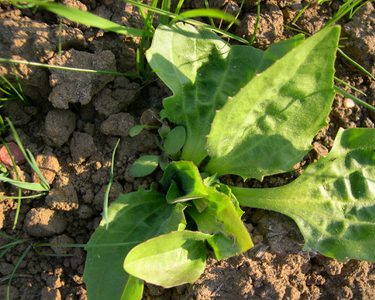Greater plantain

Other names
broad-leaved plantain, common plantain, rat-tail plantain, way-bread
Latin names
Plantago major L.
Weed Type
Perennial Broad-leaved Weeds
Where would I find Greater plantain?
It is recorded up to 1,500 ft. It is very resistant to treading, and is tolerant of both drought and waterlogging.
Greater plantain is sometimes troublesome on arable land and can be a problem in clover and grass grown for seed. It is also a common garden weed.
Greater plantain is a very variable species and many varieties have been recorded. Subspecies major is found in cultivated land and grassy places and ssp. intermedia is found near the sea. Leaf habit is under genetic control but is also influenced by the height of the surrounding vegetation. Greater plantain does not form hybrids with related species.
Greater plantain is reasonably palatable and is eaten by livestock. It contains a low level of oxalic acid and has a moderate calcium content. It has medicinal uses and was applied to wounds in the past. The leaves contain a mucilaginous sap that was used to treat sore feet.
The potato tuber rot nematode Ditylenchus destructor can infest the roots of greater plantain.
Biology
Greater plantain flowers from May to September. The flowers are wind pollinated and capable of self-fertilization. Flowering is delayed in tall vegetation. Seed is set rapidly within around 3 weeks of fertilization but is often not dispersed until the following spring. There are 23-26 seed capsules per cm length of flower spike and 9-10 seeds per capsule. An average plant may produce 14,000 seeds per year, but a large plant can have 30,000. Plants may flower and set seed just 6 weeks after germination.
Freshly shed seed does not germinate until the following spring. Germination may then occur sporadically throughout the growing season but mainly between April and August. Seeds germinate best at alternating temperatures in the light and after a period of chilling. Germination is greatest near the soil surface in open areas caused by soil disturbance. The optimum depth of seedling emergence is 0 to 5 mm and the maximum is 10 mm.
Plants form a thick rootstock with many strong roots that anchor the plant securely. On paths across grassed areas, greater plantain has small prostrate leaves and its growing point is below soil level. On the untrodden ground the leaves are semi-erect and the growing point is at soil level. In open areas greater plantain overwinters below ground but in grassland it overwinters as a small above ground leaf rosette. Root and shoot growth commences in spring and ceases by August.
Does greater plantain spread easily?
In uncultivated soil, seed has given 84% germination after 21 years and is said to remain viable for 50-60 years. Some seeds still remained viable in cultivated soil after 5 years. The annual percent decline was 38%. In dry storage seed gave 96% germination after 1 year but none was viable after 5 years.
Although a perennial, greater plantain does not reproduce freely by vegetative means and reproduction is primarily by seed. Daughter rosettes can be produced from lateral buds and plants may form a small clump.
Greater plantain seed has been a contaminant in cereal, grass and clover seed. The seeds become mucilaginous and adhesive when moist and this aids dispersal. Seed has been found in cattle, horse and goat droppings, and in samples of cow manure. Seedlings have been raised from the excreta of various birds. Seed ingested by earthworms has been recovered undamaged in worm casts.
How to manage Greater plantain organically
Cultivation in root crops will reduce greater plantain numbers. The shallow perennial taproot is readily destroyed by cultivation. Only clean crop seed should be sown.
In grassland trampling by livestock leads to soil compaction that favours greater plantain. In roadside verges, increased cutting frequency favoured greater plantain. In lawns, seed is still set and shed under regular mowing.
A large number of insects are found on greater plantain some of which feed on it.